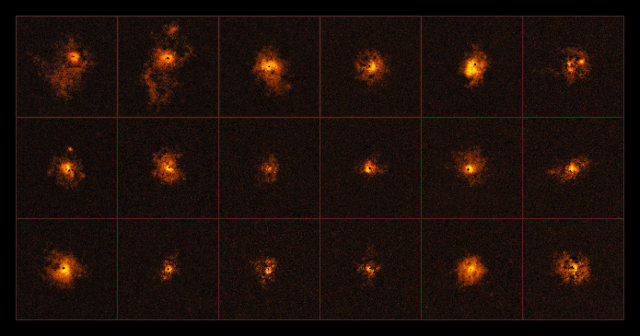
An article to be published in “The Astrophysical Journal” describes an investigation into the glowing gas clouds around distant quasars. An international team of astronomers led by a group at the ETH (Swiss Federal Institute of Technology) in Zurich, Switzerland, used the MUSE instrument mounted on ESO’s Very Large Telescope (VLT) to look at very distant galaxies that are active, of the type called quasar, and discovered that the gas halos that surround them are more common than expected.
Quasars are extremely bright objects, galaxies with nuclei that are active due to supermassive blacks holes surrounded by large amounts of materials that are heated to temperatures so high that they emit electromagnetic radiation detectable billions of light years away. According to previous surveys, about 10% of quasars examined was surrounded by gas halos, called intergalactic medium, which extend up to 300,000 light years from the center of the quasar.
In the new survey the MUSE (Multi Unit Spectroscopic Explorer) instrument was used, which combines spectroscopy and photography to observe large astronomical objects in a complete way in one shot. In this case the target was a group of 19 quasars, selected among the brightest, so distant from Earth that they appear as they were less than two billion years after the Big Bang.
According to the results of previous surveys, astronomers expected that statistically two of the 19 quasars examined were likely to be surrounded by gas halos. Surprisingly, halos surround all those 19 quasars. The chances of moving from 10% to 100% are scarce, unless the quasars included in the sample studied are in some way peculiar.
One possibility is that the MUSE instrument is so much more powerful than those used in the previous investigations that it’s the first that can detect the halos around most quasar. To test it will require additional studies and comparisons between the results of observations of these quasars conducted with different instruments.
Another surprising result of this research is the analysis of the temperature of the halos that surround the quasars. According to current models, they’re expected to have temperatures of over one million degrees, instead the gas that form halos around the quasars studied is around 10,000° Celsius, much less than expected.
The MUSE instrument provided results that are surprising and for this reason very interesting. This research may stimulate new investigations that can improve models of quasars and as a consequence of the evolution of galaxies, which are important factors at cosmological level.

